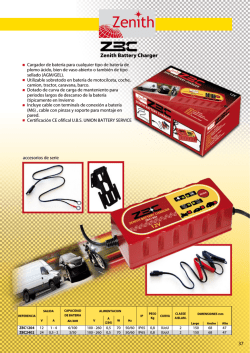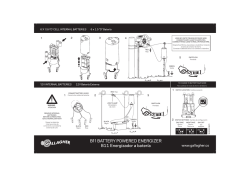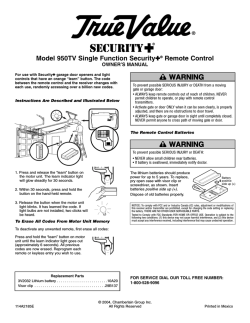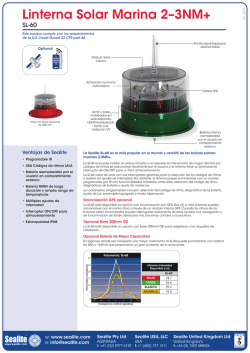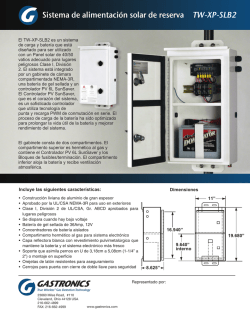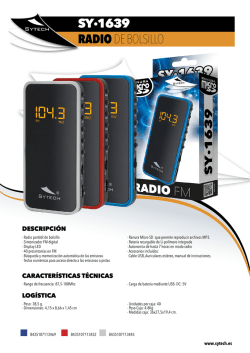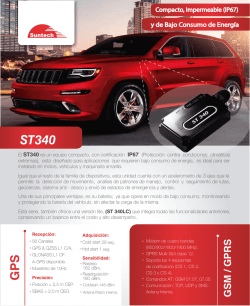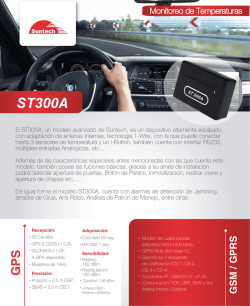
Technical support_ES_GB
TECHNICAL SUPPORT E www.ferve.com GB LA BATERÍA THE BATTERY LA BATTERIE DIE BATTERIE DE ACCU E GB F D NL PLOMO CALCIO 4 RÍA BATE 520A (EN) 1 52Ah 12V 3 2 1 Tipo de batería / Battery tipe / Type de batterie / Batterietyp / Soort accu LIQ • Batería de plomo ácido líquido: SLI (Start Light Ignition), calcio y calcio-plata. • Liquid lead-acid battery: SLI (Start Light Ignition), lead-calcium and calcium-silver. • Batterie au plomb-acide liquide : SLI (Start Light Ignition) plomb-calcium et calcium-argent. • Blei-Säure-Flüssigbatterie: SLI (Start Light Ignition), Blei-Calzium und Calcium-Silber. • Accu met vloeibaar loodzuur: SLI (Start Light Ignition), lood-calcium en calcium-zilver. GEL • Batería de plomo ácido en gel. • Lead-acid battery in gel. • Batterie au plomb-acide gel. • Blei-Säure-Gelbatterie. • Accu met loodzuur in gel. AGM • Batería de plomo ácido absorbido en fibra de vidrio: AGM (Absorbed Glass Mat). • Battery of lead-acid absorbed in glass fibre: AGM (Absorbed Glass Mat). • Batterie au plomb-acide absorbé dans la fibre de verre : AGM (Absorbed Glass Mat). • Blei-Säurebatterie mit in Glasfaservlies gebundenem Elektrolyt: AGM (Absorbent Glass Mat). • Accu met loodzuur geabsorbeerd in glasvezel: AGM (Absorbed Glass Mat). • Baterías de polímero de litio y litio-ferrofosfato (LiPO - LiFePO4) • Lithium polymer and lithium iron phosphate batteries (LiPO - LiFePO4) • Batteries en polymère de lithium et lithium-phosphate de fer (LiPO - LiFePO4) • Lithium-Polymer- und Lithium-Eisenphosphat- Batterie (LiPO - LiFePO4) • Lithiumpolymeer en lithium ferrofosfaat accu's (LiPO - LiFePO4) START STOP • Batería de plomo ácido absorbido en fibra de vidrio AGM START STOP. • Battery utilising lead acid absorbed into fibreglass AGM START STOP. • Batterie de plomb acide absorbé en fibre de verre AGM START STOP. • Blei-Säurebatterie mit in Glasfaservlies gebundenem Elektrolyt AGM START STOPP. • Loodzuur accu opgenomen in glasvezel AGM START STOP. 2 Capacidad de la batería / Capacity of the battery / Capacité de la batterie / Batteriekapazität / Vermogen van de accu (Ah) • Cantidad de electricidad que la batería puede suministrar, expresada en amperios/hora (Ah). • Amount of electricity the battery can deliver, expressed in amperes per hour (Ah). • Quantité d'électricité que la batterie peut fournir, exprimée en ampère/heure (Ah). • Menge der Elektrizität, die eine Batterie liefern kann, ausgedrückt in Ampere/Stunde (Ah). • Hoeveelheid elektriciteit die de accu kan leveren, uitgedrukt in ampère/uur (Ah). 3 Tensión / Voltage / Tension / Spannung / Spanning (V) • Diferencia de potencial entre los bornes de la batería. • Potential difference between the terminals of the battery. • Tension électrique entre les bornes de la batterie. • Potentialdifferenz zwischen den Batteriepolen. • Potentiaal verschil tussen de accupolen. 4 Intensidad / Current / Courant / Stromstärke / Intensiteit (A) • Cantidad de corriente, medida en amperios (A), que la batería puede suministrar de forma instantánea. Dependiendo del país y del fabricante, esta intensidad se rige por las normas EN, IEC, SAE o DIN. • Amount of current, measured in amperes (A), that the battery can deliver instantaneously. Depending on the country and the manufacturer, this current is governed by the EN, IEC, SAE or DIN regulations. • Quantité de courant, mesurée en ampères (A), que la batterie peut fournir de manière instantanée. En fonction du pays et du fabricant, ce courant est régi par les normes EN, IEC, SAE ou DIN. • In Ampere (A) gemessene Strommenge, welche die Batterie sofort liefern kann. Je nach Land und Hersteller unterliegt diese Stromstärke den Normen EN, IEC, SAE oder DIN. • Hoeveelheid stroom, gemeten in ampère (A), die de accu onmiddellijk kan leveren. Afhankelijk van het land en van de fabrikant, wordt deze intensiteit geregeld door de normen EN, IEC, SAE of DIN. E GB F D NL Conexión en serie Series connection Connexion en série Serienschaltung Serieschakeling + 24 V 80 Ah E GB F D NL + + 12 V 80 Ah 12 V 80 Ah Conexión en paralelo Parallel connection Connexion en parallèle Parallelschaltung Parallelschakeling + 12 V 320 Ah + + 12 V 80 Ah + + 12 V 80 Ah 12 V 80 Ah 12 V 80 Ah MEDICIONES SOBRE BATERÍAS MEASUREMENTS ON BATTERIES MEDICIÓN DEL NIVEL DE CARGA MEDIANTE LA TENSIÓN EN BORNES DE LA BATERÍA Este tipo de medición es el más empleado debido a su sencillez. Para que resulte fiable se debe realizar con equipos especialmente sensibles, dado que una pequeña variación de lectura provoca grandes desviaciones en el resultado. Presenta el inconveniente de tener que realizar la medición sobre el total de celdas de la batería. El principio de funcionamiento consiste en que, a medida que cargamos la batería, aumenta la diferencia de potencial de cada celda. Esta variación en una batería líquida va desde un valor de 1,98 V a 2,11 V. Esta variación de 0,13 V representa en una batería de 12 V (6 celdas) una variación total de: 0,13 x 6 = 0,78 V. La tabla relacional para baterías de 12 y 24 voltios tanto líquidas como de gel es: ESTADO DE CARGA STATE OF CHARGE LIQUID 12 V GEL 12 V LIQUID 24 V GEL 24 V <20% < 11.9 < 12.1 < 23.8 < 24.2 25% 12.1 12.3 24.3 24.5 50% 12.3 12.5 24.6 25 75% 12.5 12.8 25 25.5 100% 12.7 13 25.4 26 Productos FERVE relacionados: Analizadores de batería, arranque y carga, multímetros y módulos de medida, comprobador de batería y alternador, gama electrónica y puntas prueba de circuitos. MEASUREMENT OF THE CHARGE LEVEL BY MEANS OF THE VOLTAGE IN BATTERY TERMINALS This is the most common type of measurement due to its simplicity. To be reliable, this must be carried out using especially sensitive equipment, since a small variation in the reading can cause great deviations in the result. It has the disadvantage that measurement has to be performed on the total of cells in the battery. It works on the principle that the potential difference of each cell increases as the battery is charged. This variation in a liquid battery goes from a value of 1.98 V to 2.11 V. In a 12 V (6-cell) battery, this variation of 0.13 V represents a total variation of: 0.13 x 6 = 0.78 V. The table of ratios for batteries of 12 and 24 volts, both liquid and gel is: ESTADO DE CARGA STATE OF CHARGE LIQUID 12 V GEL 12 V LIQUID 24 V GEL 24 V <20% < 11.9 < 12.1 < 23.8 < 24.2 25% 12.1 12.3 24.3 24.5 50% 12.3 12.5 24.6 25 75% 12.5 12.8 25 25.5 100% 12.7 13 25.4 26 Related FERVE products: Battery analysers, start and charge, multimeters and measurement modules, F-814 battery and alternator tester, electronic range. MEDICIÓN DEL NIVEL DE CARGA MEDIANTE LA DENSIDAD DEL LÍQUIDO ELECTROLÍTICO El nivel de fiabilidad es más alto mediante este sistema que con el anterior, debido a que se comprueba la batería celda a celda. No obstante tiene el inconveniente de poder resultar peligroso, al tener que trabajar directamente con el líquido electrolítico. Las baterías de gel no admiten este tipo de medición. El principio de funcionamiento es que, a medida que la batería se va cargando, disminuye la proporción de agua (densidad = 1 g/cm3) y aumenta la proporción de ácido sulfúrico (densidad 1,8 g/cm3), obteniendo como resultado un aumento en la densidad del electrolito (de 1,100 a 1,300 g/cm3). La medida de la densidad del electrolito nos da idea del grado de carga de la batería. La relación existente es: fig.1 DENSIDAD DEL ÁCIDO DENSITY OF THE ACID 1.10 -0- DESCARGADA -50%- MEDIA CARGA 1.16 1.24 1.30 DISCHARGED HALF CHARGE -100- CARGADA CHARGED Productos FERVE relacionados: Densímetro F-425. MEASUREMENTS OF THE CHARGE LEVEL BY MEANS OF THE ELECTROLYTIC LIQUID The level of reliability is higher using this system than with the previous one. However, it has the disadvantage of having to test the battery cell by cell, as it is necessary to work directly with the electrolytic liquid. Gel batteries do not admit this type of measurement. It works on the principle that, as the battery is charging, the proportion of water decreases (density = 1 g/cm3) and the proportion of sulphuric acid increases (density 1.8 g/cm3), thus obtaining an increase in the density of the electrolyte (from 1.10 to 1.30 g/cm3).The measurement of the density of the electrolyte gives us an idea of the battery's degree of charge. The existing ratio is: (fig. 1) Related FERVE products: F-425 and F-425C density meters. MEDICIÓN DE LA CAPACIDAD DE CORRIENTE DE ARRANQUE EN FRÍO Indica el poder de arranque en amperios de la batería en función de su capacidad en amperios/hora. Existe una variación sobre este ensayo que no da resultados directos sino un resultado pasa/no pasa. Existen dos formas de realizar esta medición. Una consiste en realizar una descarga sobre la batería y observar la caída de tensión en la batería. La otra forma más compleja realiza una descarga, mide la conductancia y la tensión de la batería y, aplicando la Ley de Ohm, obtiene la corriente de arranque en frío. Productos FERVE relacionados: Analizadores de batería, arranque y carga F-1902, F-1800, comprobador de batería y alternador F-814. fig. 2 F-814 F-1902 F-1800 MEASUREMENT OF THE COLD START CURRENT CAPACITY This indicates the starting capacity in amperes of the battery, according to its capacity in amperes per hour. There is a variation on this test which does not give direct results, but rather a pass/fail result. There are two ways of carrying out this measurement. One consists of performing a discharge on the battery and observing its voltage drop. The other, more complex way, is to perform a discharge, measure the conductance and voltage of the battery, and by applying Ohm's Law, obtain the cold start current. Related FERVE products: Battery analysers, start and charge, F-814, battery and alternator tester. (fig. 2) CARGADORES: CARACTERÍSTICAS Y OPCIONES CHARGERS: CHARACTERISTICS AND OPTIONS TENSIÓN DEL CARGADOR DE BATERÍAS El valor de tensión del cargador de baterías debe ser igual a la tensión de la batería a cargar. La unidad empleada para expresarla es el voltio. Existen modelos de cargador de baterías con una o dos tensiones de salida. Los cargadores con dos tensiones de salida son más versátiles que los de una, al poder cargar una mayor variedad de baterías. VOLTAGE OF THE BATTERY CHARGER The voltage value of the battery charger must be equal to the voltage of the battery to be charged. The unit used to express this is the volt. There are models of battery charger with one or two output voltages. Chargers with two output voltages are more versatile than those with one as they can charge a greater variety of batteries. TENSIÓN DE CARGA La tensión durante la carga de la batería es mayor que la tensión de la batería en circuito abierto. Esto es debido a que se debe sumar la caída de tensión producida por la resistencia interna de la batería, así tenemos que: Tensión en carga = Tensión de la batería en reposo + (Corriente de carga x Resistencia interna) Al principio de la carga la resistencia interna va aumentando poco a poco para pasar a aumentar con rapidez al final. Se debe ir con cuidado debido a que al aumentar rápidamente este parámetro se pueden llegar a producir gasificaciones en las baterías. En los cargadores de curva W este problema se compensa ya que, aunque aumenta la resistencia interna, la corriente de carga disminuye. Los valores de tensión de final de carga recomendados son 14,8 V para baterías líquidas, 14,4 V para baterías de gel y 14,6 V para baterías AGM (incluidas las baterías AGM Start-Stop). CHARGE VOLTAGE The voltage while the battery is charging is greater than the voltage in open circuit. This is due to the fact that the voltage drop produced by the battery's internal resistance must be added, meaning that: Voltage in charge = Voltage in open circuit + (Charge current x Internal resistance) At the beginning of the charge, the internal resistance increases gradually, and then increases quickly at the end. Care must be taken, since when this parameter is increased quickly, bubbling may be produced in the batteries. In W-curve chargers, this problem is compensated since, although the internal resistance increases, the charge current decreases. The recommended end-of-charge voltage values are 14.8 V for liquid batteries and 14.7 V for gel batteries and 14.6V for AGM batteries. RANGO DE CAPACIDADES DE BATERÍA RECOMENDADO Existe una tolerancia bastante grande entre la corriente de carga ideal y el rango de capacidades de batería en el que puede utilizarse un cargador de baterías sin ninguna contraindicación. Así, y tomando como ejemplo el modelo F-905 de FERVE, que entrega 5 amperios podemos decir que es el cargador ideal para baterías de 50 amperios/hora pero, sin embargo, está recomendado para un rango de baterías entre 30 y 60 amperios/hora. RECOMMENDED RANGE OF BATTERY CAPACITIES There is quite high tolerance between the ideal charge current and the range of battery capacities in which a battery charger may be used with no contra-indication. Taking as an example the FERVE F-905 model, which delivers 5 amperes, it can thus be said that it is the ideal charger for batteries of 50 amperes per hour. However it is recommended for a range of batteries of between 30 and 60 amperes per hour. CORRIENTE DE CARGA El valor de la corriente de carga debe estar expresado en amperios aritméticos. Este es el único valor oficialmente aceptado bajo normas europeas EN 60335-2-29. No obstante, muchos fabricantes de cargadores de baterías expresan la corriente de carga de sus productos en amperios eficaces, con lo que incumplen dicha normativa europea. El motivo es que 1 amperio aritmético es igual a 1,4142 amperios eficaces. Así, un cargador de baterías de 8 amperios eficaces en realidad se debe considerar como de 5,66 amperios. Por ello, y a fin de no llevarse a engaño, es necesario saber si el fabricante del cargador de baterías utiliza amperios aritméticos o eficaces al informar de la corriente de carga. FERVE siempre expresa los valores de corriente de carga en amperios aritméticos. La corriente de carga ideal es 1/10 de la capacidad de la batería (ejemplo: 8 A para una batería de 80 Ah). Al igual que sucede con la tensión, existen cargadores con varias corrientes de salida. FERVE dispone de cargadores desde una sola corriente de salida hasta cuatro distintas. CHARGE CURRENT The value of the charge current must be expressed in arithmetical amperes. This is the only value officially accepted under the EN 60335-2-29 European regulations. Nevertheless, many battery charger manufacturers express the charge current of their products in efficient amperes, thus not complying with these European regulations. The reason is that 1 arithmetic ampere is equal to 1.4142 effective amperes. So a battery charger of 8 effective amperes must actually be considered as one of 5.66 amperes. Therefore, to avoid deception, it is necessary to know whether the battery charger manufacturer uses arithmetic or effective amperes when stating the charge current. FERVE always expresses charge current values in arithmetic amperes. The ideal charge current is 1/10 of the battery's capacity (e.g.: 8 A for a battery of 80 Ah). As occurs with the voltage, there are chargers with several output currents. FERVE chargers have from a single output current to four different ones. CURVAS DE CARGA DE CARGADORES DE BATERÍAS Expresan la forma en que el cargador de baterías entrega la energía a la batería en un periodo de tiempo. BATTERY CHARGER CHARGE CURVES The charge curve of a battery charger expresses the way in which the battery charger delivers the energy to the battery over a period of time. E GB 50,4V IUo F D NL Curva IUo: Paso 1: Intensidad constante hasta que la tensión de la batería de 48 V llega a 50,4 V. Paso 2: Se aplica una tensión constante hasta fin de carga. Paso 3: El cargador se detiene. IUo Curve: Step 1: Constant current until the battery voltage of 48 V reaches 50.4 V. Step 2: A constant voltage is applied until charging is complete. Step 3: The charger stops. Courbe IUo : Étape 1 : Intensité constante jusqu'à ce que la tension de la batterie de 48 V arrive à 50,4 V. Étape 2 : Une tension constante est appliquée jusqu'à la fin de la charge. Étape 3 : Le chargeur s'arrête. IUo-Kurve: Schritt 1: Konstante Stromstärke bis die 48-V-Batterie 50,4 V erreicht. Schritt 2: Es wird eine konstante Stromstärke bis zum Ende des Ladevorgangs angewandt. Schritt 3: Das Ladegerät hält an. IUo-kromme: Stap 1: Constante intensiteit totdat de spanning van de accu van 48 V tot 50,4 V stijgt. Stap 2: Er wordt een constante spanning toegepast totdat het laden wordt beëindigd. Stap 3. De lader stopt. TIPOS DE CARGA CHARGE TYPES CARGA MANUAL Es el tipo más extendido. El usuario es el encargado de desconectar el cargador de la batería al finalizar la carga. En casos de cargadores de batería muy potentes con respecto a las baterías a cargar, puede existir el riesgo de sobrecargas. Los cargadores manuales presentan la ventaja de poder recuperar baterías profundamente descargadas ya que no necesitan una tensión de referencia para conectarse. Curva de carga asociada: W MANUAL CHARGE This is the most common type. The user must disconnect the charger from the battery when charging is complete. In the case of very powerful battery chargers compared to the batteries to be charged, there may be a risk of overloads. Manual chargers have the advantage of being able to restore deeply discharged batteries, since they do not require a reference voltage in order to be connected. Associated charge curve: W CARGA AUTOMÁTICA PARA BATERÍAS LÍQUIDAS El cargador monitoriza totalmente la carga y puede dejarse conectado durante largos periodos de tiempo. Al llegar al máximo nivel de la batería, el cargador detiene la carga automáticamente y se elimina el riesgo de sobrecarga. Necesita una tensión de referencia para poder ponerse en funcionamiento. Curvas de carga asociadas: WoW, IoU y WoU AUTOMATIC CHARGE FOR LIQUID BATTERIES The charger monitors the charge completely and may be left connected for long periods of time. When the maximum level of the battery is reached, the charger stops the charge automatically, thus eliminating the risk of overload. It needs a reference voltage to start itself up. Associated charge curves: WoW, IoU and WoU CARGA AUTOMÁTICA PARA BATERÍAS DE GEL Y AGM Igual que la carga anterior pero con niveles de parada y conexión adaptados a este tipo de baterías. Curvas de carga asociadas: WoW, IoU y WoU AUTOMATIC CHARGE FOR GEL AND AGM BATTERIES The same as the above charge, but with stoppage and connection levels adapted to these types of battery. Associated charge curves: WoW, IoU and WoU CARGA RÁPIDA La carga rápida consiste en entregar una corriente de carga elevada durante un periodo de tiempo corto. Para evitar riesgos de sobrecargas o sobrecalentamientos, este tipo de carga viene limitada por un temporizador. Este tipo de carga sirve para baterías muy descargadas y que se deben utilizar de forma inmediata, por ejemplo antes de efectuar un arranque. FERVE dispone de una amplia gama de cargadores con función de carga rápida. FAST CHARGE Fast charge consists of delivering a high charge current over a short period. To avoid risks of overloads or overheating, this type of charge is limited by a timer. This type of charge could be interesting in deeply discharged batteries which need to be used immediately, for example, before a start. FERVE has a wide range of chargers with fast charge function. RIPPLE FREE (LIBRE DE RIZADO) En los automóviles actuales la mayoría de controles de sistemas son electrónicos. Esto hace que a veces, y especialmente en los sistemas más sensibles, la carga tradicional pueda llegar a dañarlos. El motivo es que la carga tradicional es de tipo pulsante (beneficiosa para la batería), pero la carga que devuelve la batería es continua pura. De aquí viene la recomendación de desconectar la batería del vehículo para realizar la carga. Los cargadores Ripple Free disponen de potentes filtros electrónicos gracias a los cuales se evita cualquier posible interferencia con los sistemas del automóvil. Con este tipo de cargadores no es necesario desconectar la batería del vehículo. RIPPLE FREE In the majority of today's automobiles, most of the system controls are electronic. This means that sometimes, and especially in the most sensitive systems, traditional charging could damage them. The reason for this is that traditional charging is of a pulsing type (beneficial for the battery), but the charge returned by the battery is purely continuous. This is why it is recommended to disconnect the battery from the vehicle for charging. Ripple Free chargers have powerful electronic filters, thanks to which any possible interference with the systems of the automobile is avoided. It is not necessary to disconnect the battery from the vehicle with this type of charger. VISORES DISPLAYS VOLTÍMETRO ANALÓGICO ANALOGUE VOLTMETER Comúnmente llamado de aguja. Mide la tensión en bornes de la batería y puede ser utilizado para comprobar el estado de carga de la batería. En los cargadores con curva W la aguja va aumentando de valor a medida que nos aproximamos al final de carga.Los tantos por ciento de carga vienen expresados en la parte superior. Se puede utilizar también para comprobar baterías. Commonly known as a needle voltmeter. It measures the voltage in terminals of the battery and can be used to check the charge status of the battery. In W-curve chargers, the needle increases the value as the end of the charge is approaching. The charge percentages are shown in the section above. It can also be used to check batteries. VOLTÍMETRO DIGITAL DIGITAL VOLTMETER Presenta la medición de tensión de forma digital y es más exacto que su homólogo analógico, además de presentar la ventaja de poder utilizarse con pocas variaciones como amperímetro. En los cargadores con curva W la tensión va aumentando a medida que nos aproximamos al final de carga. Se puede utilizar también para comprobar baterías y alternadores. This shows the voltage measurement digitally and is more exact than its analogue equivalent. It also has the advantage of being able to be used with few variations as an ammeter. In chargers W-curve chargers, the voltage increases as the end of the charge is approaching. It can also be used to check batteries and alternators. AMPERÍMETRO ANALÓGICO ANALOGUE AMMETER Comúnmente llamados de aguja. Mide la corriente que entrega el cargador a la batería. En los cargadores con curva W la aguja va disminuyendo de valor a medida que nos aproximamos al final de carga. Commonly known as a needle ammeter. It measures the current the charger delivers to the battery. In W-curve chargers, the needle reduces the value as the end of the charge is approaching. AMPERÍMETRO DIGITAL DIGITAL AMMETER Presenta la medición de corriente de forma digital y es más exacto que su homólogo analógico, además de presentar la ventaja de poder utilizarse con pocas variaciones como voltímetro. En los cargadores con curva W la corriente de carga va disminuyendo a medida que nos aproximamos al final de carga. This shows the measurement of current digitally and is more exact than its analogue equivalent. It also has the advantage of being able to be used with few variations as a voltmeter. In W-curve chargers, the charge current is reduced as the end of the charge is approaching. VISUALIZADOR ELECTRÓNICO Representan la información en forma de LED. Los utilizados por FERVE representan la conexión de las pinzas a la batería, el proceso de carga, el final de carga... ELECTRONIC DISPLAY This shows the information in LED form. Those used by FERVE show the connection of the clamps to the battery, the charging process,the end of the charge... HF AMP arith. AMP eff. F-2502 100-240 V ~ 50/60 Hz 30 W 12 V 4 - 45 Ah 2A 2A 110 x 48 x 32 0,257 F-2504 230 V ~ 50/60 Hz 65 W 12 V 1,2 - 120 Ah 0,8 - 4 A 0,8 - 4 A 190 x 42 x 62 0,520 F-2507 230 V ~ 50/60 Hz 135 W 12 V 14 - 230 Ah 7A 7A 205 x 52 x 95 0,810 F-2912 230 V ~ 50/60 Hz 210 W 12 V 10 - 200 Ah 2 - 6 - 12 A 2 - 6 - 12 A 240 x 285 x 130 2,200 F-3020 100-240 V ~ 50/60 Hz 360 W 12 V 45 - 225 Ah 20 A 20 A 215 x 175 x 70 1,800 F-2512 200-240 V ~ 50/60 Hz 200 W 12 V 12 - 360 Ah 3,8 - 12 A 3,8 - 12 A 230 x 63 x 135 1,425 12V 2-10-20A 24V 2-10A 265 x 115 x 145 1,470 230 V ~ 50/60 Hz 310 W 12 - 24 V 14 - 230 Ah 200-240 V ~ 50/60 Hz 500 W 48 V 20 - 120 Ah 8A 8A 225 x 80 x 120 2,000 F-4808 200-240 V ~ 50/60 Hz 500 W 48 V 20 - 120 Ah 8A 8A 225 x 80 x 120 2,000 F-1210 100-240 V ~ 50/60 Hz 180 W 12 V 45 - 120 Ah 10 A 10 A 117 x 205 x 45 1,150 F-1220 100-240 V ~ 50/60 Hz 360 W 12 - 24 V 45 - 225 Ah 12V 10-20A 24V 10A 12V 10-20A 24V 10A 201 x 205 x 45 1,860 F-1230 100-240 V ~ 50/60 Hz 540 W 12 - 24 V 45 - 225 Ah 230 x 235 x 45 2,550 F-4005 230 V ~ 50/60 Hz 332 W 4 x 12 V 30 - 60 Ah 4x5A 4x7A 450 x 250 x 90 7,800 F-705 230 V ~ 50/60 Hz 46 W 6 - 12 V 9 - 45 Ah 1,5 - 3 A 2-5A 150 x 90 x 135 1,550 F-903 230 V ~ 50/60 Hz 46 W 12 V 17 - 45 Ah 3A 5A 150 x 90 x 135 1,510 F-905 230 V ~ 50/60 Hz 83 W 12 V 30 - 60 Ah 5A 7A 150 x 90 x 135 1,970 F-805 230 V ~ 50/60 Hz 83 W 12 V 30 - 60 Ah 5A 7A 210 x 125 x 180 2,460 F-886 230 V ~ 50/60 Hz 115 W 12 V 24 - 95 Ah 4-8A 5,5 - 11 A 210 x 125 x 180 4,100 F-806 230 V ~ 50/60 Hz 115 W 12 V 24 - 95 Ah 4-8A 5,5 - 11 A 210 x 125 x 180 4,100 F-807 230 V ~ 50/60 Hz 210 W 12 - 24 V 24 - 95 Ah 4-8A 5,5 - 11 A 210 x 125 x 180 4,230 F-811 230 V ~ 50/60 Hz 177 W 12 V 35 - 140 Ah 6 - 12 A 8,5 - 17 A 250 x 145 x 210 6,320 F-812 230 V ~ 50/60 Hz 315 W 12 - 24 V 35 - 140 Ah 6 - 12 A 8,5 - 17 A 290 x 170 x 240 8,620 F-915 230 V ~ 50/60 Hz 395 W 12 - 24 V 50 - 180 Ah 8 - 16 A 11 - 22,5 A 290 x 170 x 240 9,400 F-918 230 V ~ 50/60 Hz 540 W 12 - 24 V 80 - 225 Ah 10 - 20 A 14 - 28 A 290 x 170 x 240 11,670 F-930 230 V ~ 50/60 Hz 680 W 12 - 24 V 105 - 360 Ah 15 - 30 A 21 - 43 A 360 x 205 x 260 16,750 F-908 100-240 V ~ 50/60 Hz 180 W 12 V 30 - 120 Ah 5 - 10 A 5 - 10 A 210 x 125 x 180 1,470 F-2312 230 V ~ 50/60 Hz 315 W 12 - 24 V 35 - 140 Ah 6 - 12 A 8,5 - 17 A 290 x 170 x 240 8,600 F-2316 230 V ~ 50/60 Hz 395 W 12 - 24 V 50 - 180 Ah 8 - 16 A 11 - 22,5 A 290 x 170 x 240 9,360 F-2320 230 V ~ 50/60 Hz 540 W 12 - 24 V 80 - 225 Ah 10 - 20 A 14 - 28 A 290 x 170 x 240 11,800 F-2330 230 V ~ 50/60 Hz 680 W 12 - 24 V 105 - 360 Ah 15 - 30 A 21 - 43 A 360 x 205 x 260 16,750 F-2908 230 V ~ 50/60 Hz 210 W 12 - 24 V 24 - 95 Ah 4-8A 5,5 - 11 A 235 x 140 x 195 4,900 F-2914 230 V ~ 50/60 Hz 315 W 12 - 24 V 35 - 140 Ah 6 - 12 A 6 - 12 A 290 x 170 x 240 9,160 F-2916 230 V ~ 50/60 Hz 395 W 12 - 24 V 50 - 180 Ah 8 - 16 A 8 - 16 A 290 x 170 x 240 9,460 F-2920 230 V ~ 50/60 Hz 540 W 12 - 24 V 80 - 225 Ah 10 - 20 A 10 - 20 A 290 x 170 x 240 11,760 F-2930 230 V ~ 50/60 Hz 680 W 12 - 24 V 105 - 360 Ah 15 - 30 A 21 - 43 A 360 x 205 x 260 16,700 F-2106 230 V ~ 50/60 Hz 12 W 6V 4 - 45 Ah 750 mA 1A 58 x 50 x 83 0,710 F-2201 230 V ~ 50/60 Hz 20 W 12 V 4 - 45 Ah 750 mA 1A 58 x 50 x 83 0,660 F-77 230 V ~ 50/60 Hz 166 W 12 V 30 - 115 Ah 5 - 10 A 7 - 14 A 191 x 272 x 98 4,350 F-968 230 V ~ 50/60 Hz 115 W 6 - 12 V 24 - 95 Ah 4-8A 5,5 - 11 A 210 x 125 x 180 3,500 F-909 230 V ~ 50/60 Hz 210 W 12 - 24 V 24 - 95 Ah 4-8A 5,5 - 11 A 235 x 140 x 195 4,770 mm kg F-9200 100-240 V ~ 50/60 Hz TETRA DUAL PRIMA TEN F-4808 AUTO. kg 12V 2-10-20A 24V 2-10A F-2520 F-923 230 V ~ 50/60 Hz 600 A 150 A 12V 10-20-30A 12V 10-20-30A 24V 10A 24V 10A AMP 12V AMP 24V BOOSTER FAST mm 12 V 12 / 24 V 45 - 225 Ah 30 A / 30 A 380 x 750 x 210 20,900 20 - 360 Ah 40 A / 57 A 20 A / 28 A 420 x 910 x 255 21,360 35 A / 50 A 420 x 910 x 255 23,900 arith. arith. eff. eff. arith. eff. F-925D 230 V ~ 50/60 Hz 250 A 12 / 24 V 28 - 440 Ah 55 A / 78 A F-925 230 V ~ 50/60 Hz 250 A 12 / 24 V 28 - 440 Ah 55 A / 78 A 35 A / 50 A 420 x 910 x 255 23,900 F-925RF 230 V ~ 50/60 Hz 250 A 12 / 24 V 28 - 440 Ah 55 A / 55 A 35 A / 35 A 420 x 910 x 255 24,500 F-970 230 V ~ 50/60 Hz 450 A 12 / 24 V 36 - 660 Ah 70 A / 100 A 55 A / 78 A 420 x 910 x 255 27,500 F-970RF 230 V ~ 50/60 Hz 450 A 12 / 24 V 36 - 660 Ah 70 A / 70 A 55 A / 55 A 420 x 910 x 255 28,500 F-990RF 230 V ~ 50/60 Hz 600 A 12 / 24 V A / 100 A 45 - 1000 Ah 100 arith. eff. 70 A / 70 A 470 x 1010 x 270 42,550 arith. arith. arith. arith. arith. eff. eff. eff. eff. eff. arith. arith. arith. arith. arith. arith. eff. eff. eff. eff. eff. eff. LIQ GEL AGM LITHIUM LIQ GEL AGM Ca HF AUTOMATIC MANUAL TEST CONTROL BY MICROPROCESSOR RIPPLE FREE AUTOMATIC RESTART CHARGE CURVE F-2502 IU F-2504 IU F-2507 IU F-2912 IU F-3020 IU F-2512 IU F-2520 IU TEN F-4808 F-4808 IU F-1210 IU F-1220 IU F-1230 IU FAST AUTO. TETRA DUAL PRIMA F-4005 F-705 W F-903 W F-905 W F-805 W F-886 W F-806 W F-807 W F-811 W F-812 W F-915 W F-918 W F-930 W F-908 IU F-2312 W + F-2316 W + F-2320 W + F-2330 W + F-2908 W + F-2914 W + F-2916 W + F-2920 W + F-2930 W + F-2106 WU F-2201 WU F-77 F-968 WU F-909 WU F-9200 IU F-923 W F-925D W + F-925 W F-925RF W F-970 W F-970RF W F-990RF
© Copyright 2026
